Mastering Boat Surfing: Techniques and Safety Tips
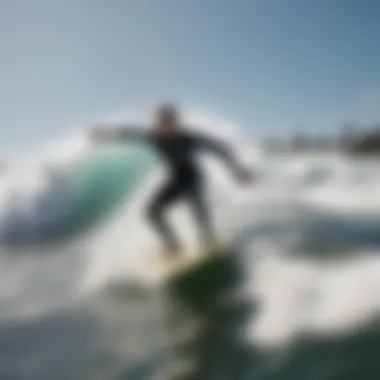
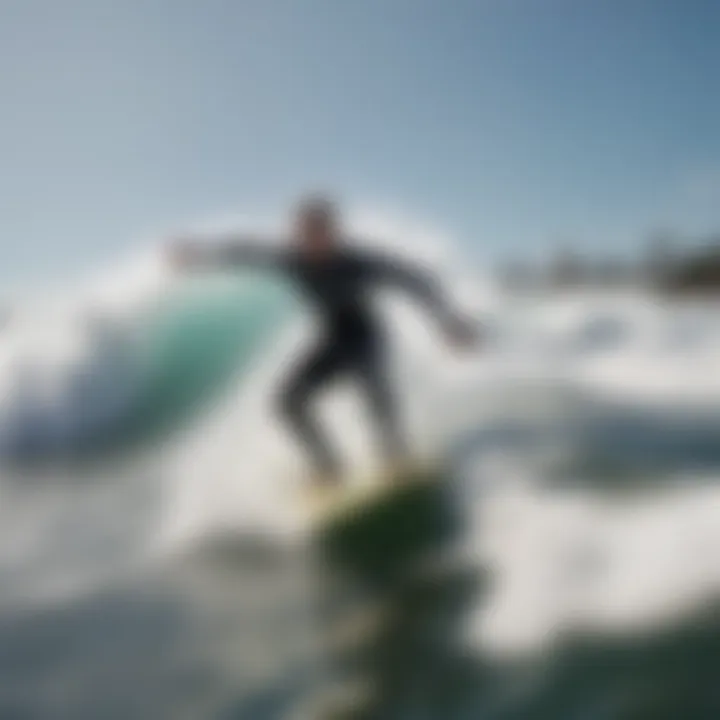
Intro
Boat surfing is becoming an increasingly popular thrill for those who love the water. It's not just about riding the waves but mastering the art of maneuvering behind a boat at high speeds. Riding the wake offers a unique experience, one that blends the excitement of traditional surfing with the controlled environment of a boat.
In this article, we’ll explore gear essentials that every boat surfer should consider. We’ll dive deep into techniques that can help both novices and seasoned surfers hone their skills. Additionally, we’ll tackle safety considerations which are paramount in any watersport.
So whether you’re itching to take your first ride or looking to polish your skills, sit back and get ready to ride the waves with confidence and flair.
Gear Essentials
Having the right gear can make all the difference in your .boat surfing experience. It's like trying to build a house without tools; just doesn't work well. Let's take a closer look at what you need to have in your kit when hitting the water.
Top Picks for Watersports Equipment
- Surfboard: Choose a wake surfboard suited for your level. A shorter board is easier for performance, while a longer one provides stability. Popular brands like Ronix or Hyperlite can serve as starters for both beginners and advanced surfers.
- Wetsuit: Depending on the climate, a good wetsuit is essential. The thickness will depend on water temperature. Look out for brands such as O'Neill or Rip Curl, known for their quality.
- Life Jacket: Make sure it’s US Coast Guard approved. A vest doesn’t just provide safety but can also enhance your buoyancy while you're learning.
- Tow Rope: A good quality tow rope designed specifically for wake surfing is a must; it helps reduce strain while you surf behind the boat. Look for one with comfortable grips.
Maintenance and Care Tips for Gear
Keeping your gear in tip-top shape ensures longevity and performance. Here are some handy tips:
- Clean Your Board: Rinse your surfboard with fresh water after each use to get rid of salt or sand build-up. Excess dirt can cause scratches over time.
- Inspect Wetsuit: After each session, rinse your wetsuit in cold water. Hang it to dry away from direct sun to prevent fading.
- Store Properly: Ensure all gear is stored in a cool, dry place. Ideally, with your board upright and away from harsh elements.
Techniques and Tips
When it comes to boat surfing, techniques can differentiate between a novice and an expert.
Beginner Tips for Each Watersport
- Positioning: When starting, keep your feet hip-width apart and bend your knees slightly. This helps stabilize your balance as you get pulled up.
- Start Slow: Begin with slowly increasing speed. Sudden acceleration can throw you off balance.
- Watch for the Wake: Learn when the best moment to pop up is. Timing is key.
Advanced Techniques for Skill Enhancement
Once you get the hang of the basics, here are some advanced tips to up your game:
- Tricks and Stunts: Start practicing spins. Simple 180s can lead to more complex flips as your confidence grows.
- Catch the Sweet Spot: Understand the boat’s wake—stay in the pocket for maximum lift.
- Balance Exercises: Practice balancing on your board in a controlled environment; this could help improve your overall surfing skills.
Remember: Safety first, always! Being aware of your surroundings and maintaining proper etiquette on the water can significantly reduce risks.
This guide has only scratched the surface of what boat surfing entails. Stay tuned for more detailed insights into techniques, gear recommendations, and safety practices to truly master the art of surfing behind a boat.
Preface to Boat Surfing
Boat surfing is a captivating water sport that blends adrenaline, skill, and the thrill of riding the waves behind a fast-moving boat. This section sheds light on its significance within the overall context of marine sports. There’s a unique camaraderie among surfers, crisp air, and the invigorating touch of water splashing all around. Not to mention, mastering the art of boat surfing not only brings joy but also enhances one’s ability to read water conditions and manage equipment effectively, which are crucial skills for any water enthusiast.
Learning about boat surfing offers countless benefits. For one, it opens up avenues for social engagement with fellow adventurers, all sharing the same passion for the water. Like-minded individuals often share tips, tricks, and local spots for the best experience. Moreover, acquiring the skills necessary for safe and enjoyable boat surfing makes each outing a fantastic opportunity to challenge oneself and push the boundaries of what one thought possible.
It is essential to underscore considerations of safety and environmental awareness as part of this exploration. Understanding how to maintain balance, navigating equipment properly, and recognizing changing water conditions can significantly mitigate risks. Therefore, this section serves as a cornerstone for readers, setting a solid foundation from which to delve deeper into the nuanced world of boat surfing.
Definition of Boat Surfing
Boat surfing, in essence, involves being towed behind a boat while riding a surfboard. The boat creates a wake that surfers can ride, catching waves similar to traditional surfing but propelled by the movement of the vessel itself. Unlike conventional surfing where one relies on ocean waves, boat surfing introduces an exciting dynamic where the speed and direction of the boat determine the experience. This sport requires not just balance but also a keen sense of timing and understanding of how to maneuver the surfboard effectively against the wake.
Safety gear plays a vital role in defining this sport. Riders usually wear personal flotation devices, ensuring their safety in case of tumbles or unexpected disruptions on the water. Not to be overlooked, the connection between the surfer and the boat is facilitated by a tow rope, which must be of quality material that can withstand the strain of towing.
History and Evolution
The roots of boat surfing can be traced back to the mid-20th century when water sports enthusiasts began experimenting with towing techniques. The concept gained traction as surfers sought new ways to enjoy their sport, far from the limitations imposed by tide and location.
In the 1960s, enthusiasts used makeshift equipment, often modifying existing boats for the unique purpose of creating ideal wakes for surfing. The sport slowly evolved, gaining popularity alongside advancements in technology. As materials and designs of surfboards improved, so did the experience of boat surfing. The 1980s saw the rise of dedicated wakeboard and ski boats, which enhanced the experience for surfers significantly.
Today, the sport is thriving. Events dedicated to boat surfing are popping up, and competitive routines are being developed, drawing talent from all over the globe. With innovations in surfboards designed specifically for this activity along with safety measures, boat surfing has transitioned from a niche hobby to a popular sport celebrated by many.
Understanding the Basics
Understanding the basics of boat surfing is crucial for anyone looking to dive into this exhilarating watersport. It sets the stage for mastering skills, safely navigating waters, and enjoying the experience to its fullest. By familiarizing oneself with the key equipment and the types of boats that enhance the activity, surfers can ensure they are well-prepared and can mitigate potential risks. It’s not just about catching a wave; it's about the entire process, from choosing the right gear to understanding the dynamics of the boat itself.
Equipment Overview
Surfboards
Surfboards are perhaps the most defining piece of equipment in boat surfing. It's the platform that allows a surfer to glide across the water, making it essential for success. Typically, a boat surfer will use a wake surfboard, which is shorter and thicker than regular surfboards, designed specifically for the unique conditions of boat wakes. The key characteristic of a wake surfboard is its buoyancy, allowing surfers to ride the wave without being pulled by the boat.
The unique aspect here is that wake surfboards often feature a swappable fin system, allowing riders to personalize their board for different maneuverability or speed. This adaptability is invaluable, especially for beginners trying to find their balance on the water. However, beginners must also be aware that not all wake surfboards are created equal; some might be specialized for performance tricks while others are aimed more at stability, so selecting the right one based on skill level is critical.
Tow Ropes
Tow ropes serve a basic but essential role in boat surfing. These ropes, generally around 70-80 feet in length, allow the surfer to securely hold on while the boat tows them into position. The integral feature of the tow rope is the handle, typically made from rubber or foam for grip and comfort.
A notable advantage of a good tow rope is that it minimizes the impact on the arms and shoulders as the boat accelerates, giving a more enjoyable experience as the surfer transitions to the wave. However, if a rope is too heavy or doesn't have the right stretch, it may lead to issues with control. Picking out a tow rope might seem insignificant, but it's an essential part of a safe trip out on the water.
Personal Flotation Devices
Personal flotation devices, often referred to as life jackets, are non-negotiable when it comes to boat surfing. They help ensure safety in the unpredictable environment of water sports. The critical characteristic of a well-fitted PFD is streamlined buoyancy, which allows for freedom of movement while still providing essential safety.
It's worth mentioning that not all PFDs are created the same; some are designed with added features like pockets for small essentials or even built-in flotation support for better stability when you take a spill. While it might be tempting to skip out on safety gear for the sake of style, doing so could have severe consequences. Choosing the right PFD is a responsibility that should not be overlooked by any serious surfer.
Types of Boats
Wakeboard Boats
Wakeboard boats are specially designed to create a massive wake that’s perfect for surfing. The primary aspect of these boats is their hull design which helps in producing a clean wave. Most come equipped with ballast systems, allowing users to adjust the boat's weight and create ideal wave conditions for surfing and tricks.
The unique selling point of wakeboard boats is their ability to create consistently rideable wakes, making them a popular choice. However, they can be costly and may require additional towing power compared to standard boats. Besides, if not used correctly, they could cause large wakes that might impact other water users.
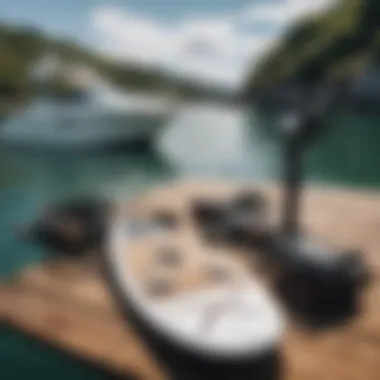
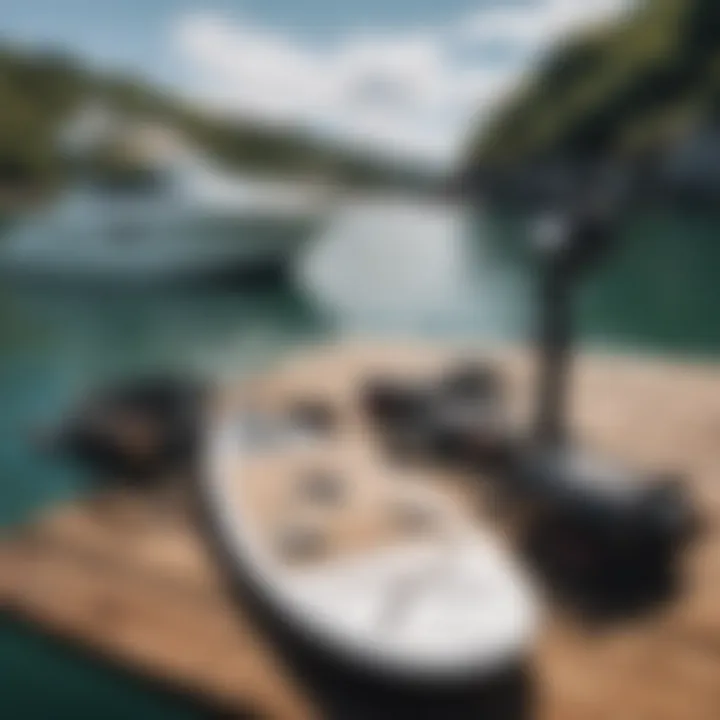
Ski Boats
Ski boats are another popular type for boat surfing, designed for speed and agility on the water. Their sleek designs allow for fast acceleration, enabling quick transitions from calm cruising to surfing mode. Ski boats are typically lighter than wakeboard boats, which can be an advantage when towing larger groups.
The downside? The wakes produced may not be as ideal for surfing as those generated by specially designed wakeboard boats. While they are versatile, individuals looking to master boat surfing may find themselves needing to adjust more actively to the water conditions.
Luxury Boats
Luxury boats might not be the first option that comes to mind when you think of boat surfing, but they have a niche appeal. These vessels often feature state-of-the-art amenities, making for a lavish surfing experience. They typically have advanced wake systems and extra comfort options like lounges or shaded areas.
However, the cost of maintaining luxury boats can be prohibitive for some, and they may sacrifice some performance for added comfort. They may not be the best choice for serious surfers focused on improving their skills, but for leisure and casual enjoyment, they provide a unique experience.
Techniques for Successful Boat Surfing
Mastering boat surfing is not just about crossing waves; it hinges importantly on refined techniques that ensure both enjoyment and safety. Techniques play a massive role in how one navigates the waters, which in turn impacts overall performance. They can mean the difference between a thrilling ride and an awkward tumble into the water. Focusing on proper practices allows surfers to harness the power of the boat effectively while maintaining control over their boards. Let's break it down into key components to understand how best to execute the sport.
Choosing the Right Spot
Calm Waters
Selecting calm waters is fundamental for a successfull boat surfing experience. Unlike rough or choppy surfaces, calm waters offer a stable platform where surfers can find balance more easily. This makes it a popular choice, especially among beginners. The key characteristic here is that it reduces the unpredictability that comes with wave action, allowing riders to focus on mastering their skills rather than keeping afloat.
Differences in waves can greatly affect one's surfing experience. The unique feature of calm waters is its smooth surface, which enhances the glide of the board. However, an aspect that some may find less favorable is that it might lack the excitement associated with more turbulent conditions, potentially making it feel somewhat monotonous after a while.
Sufficient Space
Another crucial component in choosing the right spot is ensuring there’s sufficient space for both the boat and surfer. This factor heavily contributes to a safer surfing environment. Open areas minimize the risks of collisions with obstacles such as rocks or swimmers. A significant characteristic of having enough space is that it allows for freedom of movement, enabling surfers to practice tricks or maintain control without feeling cramped.
A unique feature of open water is that it also allows the surfer to maneuver away from the boat when necessary, which is crucial if things unexpectedly go sideways. However, the downside might be that finding these aptly spaced areas can sometimes pose a challenge, especially in highly populated water sport zones.
Positioning and Balance
Stance on the Board
Your stance on the board can significantly affect how you ride. Having the right footing is essential for enhancing stability. A good stance generally involves a slightly bent knee position and feet shoulder-width apart, matched alongside the direction of the boat's movement. This stance is particularly beneficial as it centers your gravity directly over the board, allowing for quick adjustments mid-surf.
This characteristic of stance not only promotes a better riding experience but also contributes to overall safety by reducing the risk of falls. However, maintaining this positioned balance can be tricky for some, particularly in the beginning, where incorrect stance may lead to frequent wipeouts and minor injuries as they learn.
Weight Distribution
Equally important is how weight is distributed on the board. Mastering weight distribution can dictate the board's response to movement. A good surfer maintains a light forward lean during acceleration, shifting the weight back when approaching turns. This balance of weight essentially helps the board to glide and react more dynamically to the waters.
Weight distribution is most advantageous during transitions, such as turning or taking off from a wake. However, the challenge arises here when surfers misjudge weight placement, leading oftentimes to unintended tumbles.
Starting Techniques
Towing Method
The towing method serves as a key initiation phase for any surfer looking to start riding behind a boat. This involves the boat slowly accelerating to create a wake that the surfer can utilize. The advantage of this method lies in its simplicity; as you start, the pull of the boat helps you gain speed without excessive effort. It also provides a controlled way to begin, which increases confidence levels for newcomers.
However, a unique feature of towing is that it requires clear communication with the driver. If the boat goes too fast or too slow, the rider's ability to catch the wake might be compromised.
Transition from Water to Board
The moment when a surfer transitions from being in the water to standing on the board is pivotal. Gradually pulling oneself onto the board using the grip of the tow rope, while executing balanced movements is essential. This phase is crucial as the wrong technique can lead to immediate falls right from the get-go.
The fact that this method sets the tone for the entire surf session is its main advantage. It reinforces that if a solid transition is achieved, the performance on the board is likely to follow suit. Nonetheless, if not practiced adequately, this technique can become a stumbling block, often leading to early frustrations for those just getting into the sport.
In summary, mastering boat surfing techniques significantly enriches the experience, allowing both novices and seasoned surfers to excel and find joy in their efforts. Every detail counts—whether it's the choice of water or the precision of stance and transitions. Good practices lead to stronger performances and better safety on the water.
Safety Precautions
Safety precautions are a cornerstone of boat surfing, not only ensuring an enjoyable experience but also safeguarding against potential hazards. Engaging in this sport without taking safety seriously can lead to accidents that may endanger lives and ruin the fun. It's imperative that surfers develop an understanding of the various safety protocols before even stepping onto the water.
One of the primary considerations has to do with environmental factors, such as water conditions and weather. Strong waves, swift currents, or sudden weather changes can pose risks that a novice surfer might not anticipate. Remaining vigilant and informed can greatly reduce these risks.
Understanding Water Conditions
Being mindful of water conditions is essential for a safe and fulfilling boat surfing experience. Recognizing how elements like waves and currents interact can alter one’s approach to surfing altogether.
Waves and Currents
Waves can vary dramatically from calm swells to choppy surfaces, and each type contributes differently to the surfing experience. For instance, gentle waves may provide a relaxed ride, allowing for easier tricks and jumps. Meanwhile, strong waves bring challenges that test a surfer’s skill and balance. Strong currents, on the other hand, can sweep away even the most experienced surfers.
In this article, understanding the dynamics of waves and currents is essential for selecting appropriate surfing spots. A deeper insight can lead you to locations that offer safe conditions and exciting rides. For example, riding with a current can enhance your surfing speed while dodging against it can lead to fatigue.
Weather Conditions
Weather plays a critical role in determining whether the day is suitable for boat surfing. High winds can whip up waves and create conditions that are less than ideal. It’s not just about enjoying the sun; storm clouds and lightning can crop up unexpectedly.
Being aware of upcoming weather patterns ensures you’re not caught off guard. This article emphasizes how checking the weather forecast and understanding local conditions can lead to better decision-making. A sunny day can turn into something quite different if you're not monitoring the skies. Sudden drops in temperature can lead to hypothermia, especially if you fall into colder waters.
Rescue Techniques
When fun turns to fright, knowing rescue techniques can be a lifesaver. It’s not enough to simply enjoy the waves; being equipped with a solid safety plan is just as crucial.
Creating a Safety Plan
Creating a safety plan begins with prepping for any possible outcome, be it a minor mishap or a more serious situation. Understanding locations where help is readily available and having designated communication methods in place is vital.
An effective safety plan considers factors such as emergency contact lists, first aid kits, and proper signaling devices. In our guide, a well-structured safety plan is emphasized as an indispensable safety measure. For example, in the event of a fall, knowing the nearest point of assistance and how to alert others can drastically change outcomes.
Emergency Signals


Signal recognition can often be overlooked, yet they're critical in emergencies. Understanding how to communicate distress visually or audibly, especially in a boat surfing scenario, is paramount.
Different signals exist for various situations. For instance, raising both hands in the air can signify the need for help. Knowing these signals and ensuring all participants are aware can unite actions ensuring everyone’s safety. This article focuses on how clear communication can aid in navigating risky situations.
Equipment Safety Checks
Regular equipment safety checks can make the difference between a fun day and a disastrous one on the water. Just like checking the oil in your car, ensuring your gear functions properly before heading out is essential.
Inspecting Gear
Inspecting gear before surf time should become second nature. That includes everything from surfboards to life jackets. A small crack in the board or a worn-out strap can easily lead to serious accidents.
Each surfboard should undergo a thorough check. Look for any dents, cracks or other damage that could affect performance. Likewise, life jackets should be inspected for buoyancy and overall condition. In this article, we make it clear that prevention keeps both surfers and instructors safe.
Ensuring Boat Readiness
This goes hand in hand with gear inspections. Boat readiness means making sure that the engine is functional, safety equipment is readily available, and everyone knows emergency exits or procedures. A well-maintained boat reduces the likelihood of breakdowns, allowing for a smooth sailing experience.
Safety isn’t just a checkmark; it’s a lifestyle in the world of boat surfing. With proper understanding of water conditions, rescue techniques, and equipment safety checks, surfers can focus on mastering their craft while keeping enjoyment at the forefront.
Environmental Considerations
When it comes to boat surfing, grappling with the complexities of the environment around us is crucial. Understanding the delicate balance between enjoying water sports and safeguarding natural habitats not only enhances our experiences but also ensures the sustainability of these precious ecosystems. For surfers, this means tuning in to the nuances of wildlife and minimizing our footprint on nature.
Respecting Wildlife
Respecting wildlife is no mere afterthought; it's a fundamental responsibility that each surfer should carry. Whether it's avoiding nesting areas of birds along the shore or steering clear of marine wildlife during breeding seasons, being aware of our surroundings keeps both us and the ocean's inhabitants safe. For example, dolphins, with their playful leaps and spins, often catch our eyes, but it's important to give them space and not disrupt their natural behaviors. Educating yourself about local wildlife can truly enrich your surfing experience.
Did you know? By adhering to guidelines protecting endangered species, you contribute to the preservation of biodiversity and help maintain vibrant ecosystems.
- Key Practices:
- Observe from a distance.
- Refrain from feeding wild animals.
- Always adhere to posted signs regarding wildlife.
Minimizing Environmental Impact
Little efforts can lead to significant change. Minimizing environmental impact isn't just a trend; it's a commitment to our waterways and wildlife. Let's delve into some details on how boat surfers can contribute positively to the environment, starting with responsible waste management.
Discarding Waste Responsibly
One critical aspect of minimizing environmental impact involves discarding waste responsibly. This encompasses everything from packing out trash to ensuring that any gear used on the water doesn’t leak harmful substances. Responsible disposal not only keeps our oceans clean but also safeguards marine life that could ingest plastic or become entangled in waste. A key characteristic of discarding waste properly is the act of recycling when possible and utilizing proper waste receptacles.
This choice is beneficial because it showcases our respect for the environment. Moreover, a clean waterway is a testament to the community's values and can often reflect the quality of experiences available. Think about it: a picturesque lake, unmarred by litter, is far more inviting for a day of surfing.
- Unique Features:
- Bringing necessary gear to collect waste encourages a positive mindset.
- Organizing community clean-ups fosters a sense of unity and responsibility among surfers.
Avoiding Sensitive Areas
Avoiding sensitive areas is another practice that greatly contributes to environmental conservation. These areas often serve as critical habitats for wildlife or are sensitive to disturbances from noise, pollution, or motor wake. For instance, circumnavigating seagrass beds or coral reefs can protect the intricate ecosystems that depend on them. The nature of this approach is beneficial not just for the environment, but for the surfers themselves—by respecting these zones, surfers contribute to the health of the marine ecosystem and ensure its continued beauty.
- Important Considerations:
- Familiarize yourself with local regulations about sensitive habitats.
- Use maps to chart out areas to avoid when planning your surfing days.
In essence, being a responsible surfer means taking accountability and making conscious choices that favor both the enjoyment of water sports and the preservation of the environment.
Advanced Techniques for Experienced Surfers
Mastering the complexities of boat surfing involves more than just getting up on the surfboard. For those seasoned in the sport, advanced techniques not only amplify performance but also diversify the experience on the water. These techniques can elevate an average outing into something spectacular, whether you are looking to impress, compete, or simply push your boundaries.
Advanced surfing techniques often have unique demands in terms of skill, balance, and timing. They provide surfers the opportunity to express flair while maneuvering through waves produced by the boat. With the integration of tricks, stunts, and competition preparation, experienced surfers can truly master the art of boat surfing.
Tricks and Stunts
Flips
Flips represent a bold move that turns heads on the water. This trick involves rotating the body in the air while maintaining hold on the tow rope and control over the surfboard. A standout characteristic of flips is how they symbolize not just technical prowess but a confident approach to the sport.
This maneuver is popular among many seasoned surfers for a reason. Flips amplify the thrill while offering a sense of accomplishment. Successfully landing a flip can feel like a rite of passage, creating a rush that is hard to match. However, it comes with notable risks; the timing and technique must be spot-on. An improperly executed flip can lead to spills that may result in injuries.
Therefore, practicing flips should be done in controlled environments with enough space and supervision. This way, safety remains paramount while embracing the adrenaline of the sport.
Grabs
Grabs add a unique flair to boat surfing and allow surfers to connect visually with the audience as they perform. This technique involves reaching down to grab the surfboard mid-air while executing jumps or spins. A key characteristic of grabs is their ability to enhance the visual appeal of a rider’s performance, making it a favorite among competitive surfers.
In terms of benefits, grabs highlight creativity during a routine. They also help stabilize the board in air, providing an added advantage for maintaining balance. However, the downside is that they can be risky if the timing isn't right. If a grab is poorly executed, it might hinder landing control, leading to falls or even unintentional wipeouts.
Competitive Boat Surfing
Understanding Competitions
For surfers looking to transition from recreational riding to competitive boat surfing, understanding competitions is crucial. Competitions serve as a platform for surfers to showcase their skills, creativity, and technical abilities in a structured environment. This not only motivates athletes to push their limits but also fosters a sense of community among surfers.
One major aspect of competitions is the categorization of events that may vary. Some focus purely on tricks while others might emphasize style and flow. Understanding these distinctions can be beneficial for competitors in tailoring their training and performances to align with the specific demands of upcoming events.
Competing can also lead to opportunities for sponsorships and greater visibility in the water sports community. This, however, comes with the need for rigorous training and practice.
Judging Criteria
The judging criteria in competitions can be rather intricate, as it encompasses various factors influencing a competitor's performance. Key elements such as difficulty, execution, and overall flow contribute heavily to scores awarded by judges. This reflects what the audience sees and hones on the technical aspects of performances.

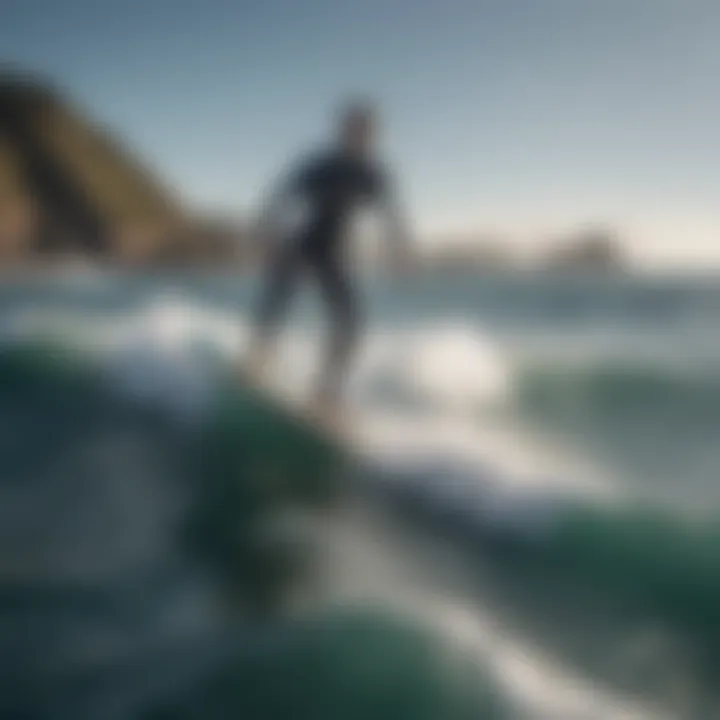
Highlighting creativity in a routine, judges may also consider how well a surfer integrates flips and grabs into their presentation. This aspect is essential, as the unique features of these tricks can either enhance or detract from a routine’s overall effectiveness.
Understanding these criteria can help surfers hone their skills to meet what judges look for, yet this could also lead to performance anxiety for some. Balancing the fun of the sport with the seriousness of competition remains important.
"In the end, the thrill of boat surfing comes not only from the ride but from sharing those moments and memories with fellow enthusiasts. Engaging in advanced techniques, competitions, and learning as a community makes every wave worth riding."
Thriving within the world of boat surfing requires a deep understanding of these advanced techniques, paving the way for profound experiences and potential accolades on the water.
Maintenance of Equipment
Maintaining your equipment is not just a chore; it is essential to enjoying boat surfing safely and effectively. Whether you are a weekend warrior or a seasoned surfer, the condition of your gear significantly impacts performance. Regular upkeep can not only extend the life of your surfboard and boat but also enhance your overall experience on the water. Good maintenance practices create a platform for skill development, ensuring that you can focus on mastering your techniques without distractions and worries about potential mishaps.
Caring for Your Surfboard
Regular Inspections
Regular inspections are at the heart of caring for your surfboard. You can liken this practice to keeping an eye on your car to avoid breakdowns. During these checks, look for cracks, dings, or any wear on the waxed surface. These damages can affect how the board moves through water. Often, surfers neglect this aspect, thinking a bit of wear and tear is part of the game. However, catching issues early saves money in the long run and helps to prevent accidents while riding the waves.
One key characteristic of regular inspections is their simplicity. They don't require specialized skills or tools. A surfer looking closely at their board after every surf session can spot problems and address them swiftly.
However, the unique feature here lies in consistency. If you’re out on the water daily, the wear can accumulate quickly, meaning inspection frequency should match usage intensity. Being proactive promotes long-lasting durability.
Repair Techniques
When it comes to keeping your surfboard in shape, knowing repair techniques is crucial. Just like any sport, accidents happen, and your board can sustain damage from an unexpected wave or contact with another surfer. Having the skills to repair minor lapses not only increases your confidence but can also eliminate downtime, allowing you to hop back on the water sooner.
A recognized aspect of repair techniques is the DIY aspect. Many surf shops sell repair kits containing resin and fiberglass allowing surfers to patch up small holes and dents by themselves. This can save time and also the cost of professional repairs.
Moreover, one unique feature of mastering repair techniques lies in the learning opportunity behind it. Each fix is a chance to understand your board better. The drawback, however, is that not all repairs are straightforward; larger damages might require professional attention to ensure safety and performance integrity.
Boat Maintenance
Engine Checks
Regular engine checks are the backbone of boat maintenance. Think of the engine as the heart of your vessel—it needs to pump effectively to get you where you want to go. Without proper functioning, the thrill of boat surfing can turn into a nightmare if the engine fails during a session. By conducting engine checks before hitting the water, you can verify fuel levels, inspect the oil, and look for any leaks or damages.
One critical characteristic of engine checks is routine. These shouldn’t be last-minute checks; they should be integrated into your pre-surf ritual. This proactive approach ensures you have removed potential issues before they can become a concern.
A unique aspect of engine checks is their influence on the overall safety of everyone on board. Also, an engine delay can ruin a good surf day; when you're ready, you want to hit the waves! Ignoring these checks can lead to costly repairs and equipment failures — and nobody wants that.
Safety Equipment Verification
Safety equipment verification is a pivotal aspect of being a responsible boater and surfer. Life jackets, first aid kits, and flares are not just for show; they are lifesavers in critical situations. A keen eye on these elements ensures that you and your crew are prepared for the unexpected.
The characteristic of safety equipment verification is its simplicity: it's about checking that you have the basics and that they are in working order. This process means looking for signs of wear and ensuring everything functions as it should, left unchecked, even the simplest thing like a frayed life jacket strap can be severely hazardous.
The unique feature here is the peace of mind it offers. Knowing that you are prepared for mishaps, big or small, elevates your confidence level, allowing you to focus on honing your surfing skills without removing your attention from safety aspects. One drawback, though, is that the list can be overwhelming to keep track of, so developing a consistent checklist can help in these situations.
Community and Connectivity
In the world of boat surfing, the significance of community and connectivity cannot be overstated. Engaging with fellow enthusiasts not only enhances the experience but also provides a safety net—both literally and figuratively. When surfers connect with one another, they share knowledge, tips, and local spots where the waves are just right. These connections form a support network that can lead to improved skills and deeper understanding of the sport.
Connecting with Other Surfers
Joining Clubs
Joining clubs is one of the most effective ways to dive into the boat surfing community. These organizations often foster a sense of belonging, allowing members to develop friendships with those who share a similar passion. Notably, clubs typically organize activities and excursions that enhance your surfing experience. For instance, a club may have regular meet-ups at local lakes or rivers where members can practice techniques together.
Moreover, being part of a club often provides access to exclusive resources like experienced instructors or group discounts on equipment. The collaboration helps in building skills while ensuring safety on the water, making it a popular choice. However, a downside can be the initial intimidation one might face; joining a club can feel like entering a new circle where everyone seems advanced. But don't fret, every surfer had to start somewhere.
Participating in Events
Participating in events is another way for surfers to engage with the community and hone their skills. Such events can range from competitions to casual local gatherings, each providing a unique experience. Events are excellent for learning from others; seeing different techniques in action helps in developing one’s own approach. Plus, there’s an undeniable excitement that comes from being part of a larger gathering.
The key characteristic of these events is their ability to foster a spirit of camaraderie, with participants cheering each other on, regardless of skill level. This sense of community makes events beneficial for mental well-being and motivation. However, newcomers might find high-stakes competitions overwhelming. It's crucial to find events suited to one’s skill level to reap the maximum benefits without the pressure.
Online Resources and Forums
In today’s digital age, online resources and forums have emerged as vital components of the boat surfing landscape. The wealth of information available can range from tips for beginners to advanced techniques, making them indispensable for surfers looking to learn and connect.
Social Media Groups
Social media groups have transformed the way surfers interact. These platforms create a space where individuals can share insights, post videos of their latest rides, and seek advice. The immediacy of social media allows for real-time interaction, making it easy to stay updated on trends or local happenings. Anyone can post a query about gear or conditions in their area, drawing responses quickly from experienced surfers.
However, one should be mindful of the varying levels of expertise in these groups. Sometimes, information shared might not be the most reliable. Filtering through opinions and identifying credible sources is key to drawing value from these communities. Still, the sense of belonging often outweighs the potential pitfalls.
Sharing Experiences
Sharing experiences in the context of boat surfing creates invaluable learning opportunities. This can happen through blogs, vlogs, or forums where surfers document their journeys. Experiences shared can encompass everything from personal challenges, like learning a new trick, to insights about navigating specific waters.
This communal aspect serves to inspire and motivate others within the community, reinforcing the notion that every surfer has faced similar hurdles. Moreover, it contributes to a collective knowledge base where veteran surfers can impart wisdom while newcomers find their footing. While this practice certainly cultivates camaraderie, it can sometimes lead to a sense of comparison and competition. Staying focused on personal progress ensures a positive experience.
"The surfer who knows the most has not simply caught the biggest tricks, but effectively shared the most with others."
Building connections within the boat surfing community, whether through clubs, events, or online platforms, can greatly enrich the surfing experience. The knowledge exchanged and friendships formed create a robust environment for growth, ensuring that both novice and expert surfers alike can thrive on the waves.
Closure
In wrapping up our discussion on boat surfing, it's essential to grasp the significance of this sport not only as a thrilling activity but also as a skill that requires careful consideration of various elements. The journey of mastering boat surfing isn't just about catching waves; it involves diving deep into the intricacies of techniques and embracing the safety measures that go along with them. Each part of this article highlights crucial aspects that contribute to a successful and enjoyable experience.
Recap of Key Points
- Techniques and Safety: Understanding the interplay between proper techniques and safety precautions is paramount. Whether it’s knowing how to maintain balance or recognizing changing water conditions, both elements are critical for a safe surfing experience.
- Equipment Maintenance: We covered the importance of regular equipment checks—ensuring that both the boat and surf gear are in top shape can prevent mishaps that could spoil a day on the water.
- Environmental Awareness: Respect for the environment—a crucial concern for boat surfers—was emphasized, highlighting how our actions can impact wildlife and natural water bodies. Awareness fosters not just recreational enjoyment but also responsible stewardship of the waters we love.
- Community Engagement: Lastly, connecting with fellow surfers enriches the boating experience. With resources ranging from social media platforms to local clubs and events, being a part of the boat surfing community can deepen one’s knowledge and enhance camaraderie.
Looking Ahead: The Future of Boat Surfing
As we look toward the horizon of boat surfing, several trends emerge that could transform the landscape of this sport. Advances in technology—like electric surfboards and enhanced safety gear—promise to make boat surfing more accessible and safer than ever before. Plus, there's a growing environmental consciousness among surfers that’s likely to shape practices and regulations in the coming years.
Moreover, as outdoor sports gain more popularity, the community around boat surfing is expected to expand, creating opportunities for mentorship and shared experiences. Innovations in teaching techniques will benefit newcomers, helping them grasp the nuances of boat surfing with greater ease.
Finally, collaborations with environmental groups can ensure that the future of boat surfing is not only thrilling but also sustainable. We’ve seen how awareness and education can lead to responsible water use, setting an example for future generations. Embracing these changes will play a pivotal role in keeping the spirit of boat surfing alive and well for years to come.



